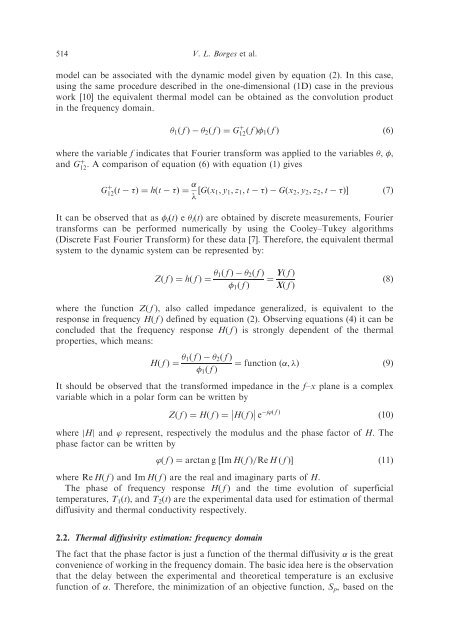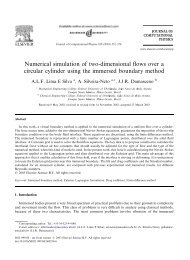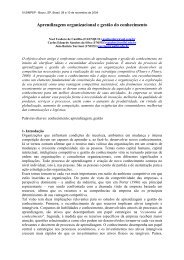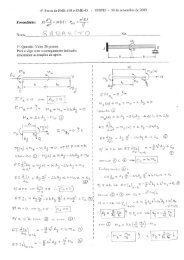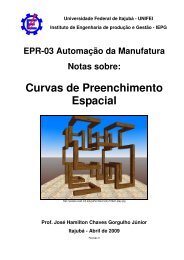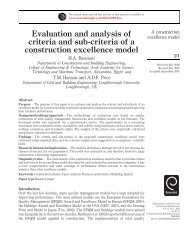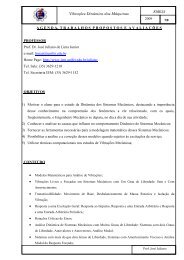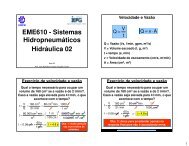A dynamic thermal identification method applied to condutor ... - IEM
A dynamic thermal identification method applied to condutor ... - IEM
A dynamic thermal identification method applied to condutor ... - IEM
You also want an ePaper? Increase the reach of your titles
YUMPU automatically turns print PDFs into web optimized ePapers that Google loves.
514 V. L. Borges et al.model can be associated with the <strong>dynamic</strong> model given by equation (2). In this case,using the same procedure described in the one-dimensional (1D) case in the previouswork [10] the equivalent <strong>thermal</strong> model can be obtained as the convolution productin the frequency domain. 1 ð f Þ 2 ð f Þ¼G þ 12 ð f Þ 1ð f Þ ð6Þwhere the variable f indicates that Fourier transform was <strong>applied</strong> <strong>to</strong> the variables , ,and G þ 12. A comparison of equation (6) with equation (1) givesG þ 12 ðt Þ ¼hðt Þ ¼ ½ Gðx 1, y 1 , z 1 , t Þ Gðx 2 , y 2 , z 2 , t ÞŠ ð7ÞIt can be observed that as i (t) e i (t) are obtained by discrete measurements, Fouriertransforms can be performed numerically by using the Cooley–Tukey algorithms(Discrete Fast Fourier Transform) for these data [7]. Therefore, the equivalent <strong>thermal</strong>system <strong>to</strong> the <strong>dynamic</strong> system can be represented by:Zð f Þ¼hð f Þ¼ 1ðfÞ 2 ðfÞðfÞ 1¼ Yð f ÞXð f Þð8Þwhere the function Z( f ), also called impedance generalized, is equivalent <strong>to</strong> theresponse in frequency H( f ) defined by equation (2). Observing equations (4) it can beconcluded that the frequency response H( f ) is strongly dependent of the <strong>thermal</strong>properties, which means:Hð f Þ¼ 1ð f Þ 2 ð f Þ¼ function ð, Þð9Þ 1 ð f ÞIt should be observed that the transformed impedance in the f–x plane is a complexvariable which in a polar form can be written byZð f Þ¼Hð f Þ¼Hð f Þ ej’ð f Þð10Þwhere jHj and ’ represent, respectively the modulus and the phase fac<strong>to</strong>r of H. Thephase fac<strong>to</strong>r can be written by’ð f Þ¼arctan g ½Im Hð f Þ=Re H ð f ÞŠ ð11Þwhere Re H( f ) and Im H( f ) are the real and imaginary parts of H.The phase of frequency response H( f ) and the time evolution of superficialtemperatures, T 1 (t), and T 2 (t) are the experimental data used for estimation of <strong>thermal</strong>diffusivity and <strong>thermal</strong> conductivity respectively.2.2. Thermal diffusivity estimation: frequency domainThe fact that the phase fac<strong>to</strong>r is just a function of the <strong>thermal</strong> diffusivity is the greatconvenience of working in the frequency domain. The basic idea here is the observationthat the delay between the experimental and theoretical temperature is an exclusivefunction of . Therefore, the minimization of an objective function, S p , based on the


